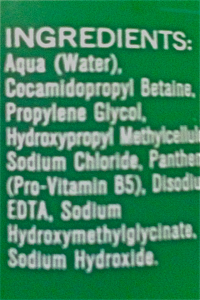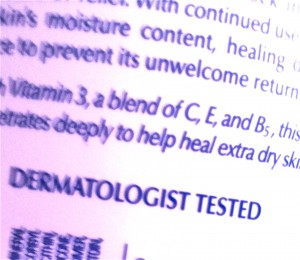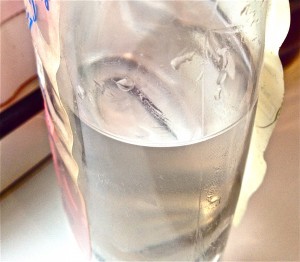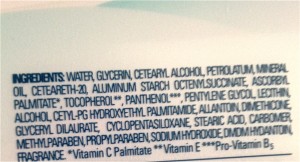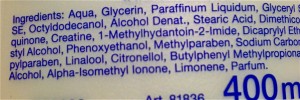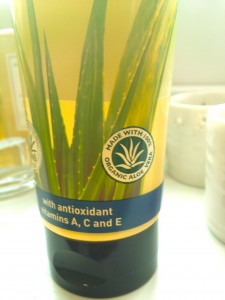Concerns about lab created ingredients run rife with many of us. In the last post I mentioned that there are a number of ingredients that occur frequently in skin care products that have raised a few eyebrows to say the least, and raised our chance of a fatal disease to say the most.
It has been pointed out to me that Over-The-Counter products cannot actually change your skin otherwise they would have to be labelled as a medicine. As one expert puts it, ‘No OTC cosmetic product is legally allowed to make ANY change to the skin because if it did, it would be a medicine and have to be bought on prescription, [that] is enough evidence in itself to show that the industry is not there for the love of beauty!’
Hmmm…this is immediately food for thought. Does this render the whole skincare business, at least at the level we are discussing here, utterly redundant?!? I will have to come back to this, clearly, but let’s press on for the time being and explore the products and the ‘reactions’ they do create, at least at the shallowest level, and see if we can make a bit of sense of this.
A common overall concern is that the ingredients that are in our everyday products might stay in our body and build up over time to reach unsafe levels. This process is called bioaccumulation. This has probably been around as a factor in our lives forever but of course we can actually detect these things now with our technological advancements. Well, that’s progress right…?
Arguably detecting the presence of an ingredient in the body is not evidence of bioaccumulation or of any harm being done subsequently. It simply shows that the person has come into contact with that ingredient at some point. The supporters of this theory will expound upon the miraculous efficiency of our bodies and say how our bodies are especially adept at eliminating undesirables from itself, but they also rely on us not questioning this…
The potential for bioaccumulation is one of the factors that scientists look for when assessing whether an ingredient is safe to use or not. As I said before, all products must be ‘rigorously assessed for safety’ by appropriately qualified and authorised personage before they may be placed on the market. The safety assessment is supposed to take into account all the different situations and conditions in which the products are likely to be used. This is all well and good for individual products but I am beginning to wonder what if the same ingredients occur in the many different products I use, and therefore the cumulative use of these so-called safe products might become unsafe? Is that possible? Do these super qualified scientists test for that too? Hmmm…it’s unlikely they do isn’t?
I was given this example and I add it here for us all to think about…
‘Let’s take Sodium Hydroxymethylglycinate, for example, a preservative often used in ‘natural’ products. It is an inert salt distilled from soy glycine with one of the lowest reaction rates of any preservative used on skin care.
HOWEVER it is made with formaldehyde and can break down back into formaldehyde at 1% concentration. Bearing this in mind we’d use it at a maximum of 0.5% in the EU, and so this breakdown is highly reduced – apparently 1 in 2,500 applications, or using it once a day, every day for 7 years.
And so it is allowed. But what if we use face cream twice a day? And what if it’s also in our cleansers, our eye creams, shampoo and body wash? That’s just over a year before the ‘risk’ of formaldehyde build up occurs. And even if it’s 7 years, wouldn’t you rather not take the risk if an alternative was available?’
Hmmm…preservatives are the stickiest of these quandaries. A product pretty much has to have a preservative in it to last more than a day or two right? So we are on the search for a friendly one aren’t we? Right let’s get picking through the carcasses of these ingredients…
These are a few ingredients you may well have seen and heard denounced on the packaging of the ‘natural’ brands products. Conversely, the beauty industry justifies and substantiates these additions and blames the media for jumping on some flimsy new band wagon and vilifying them when in scientific tests they are safe and effective and have been passed by the EU as safe after rigorous testing. Who can we trust?!?
Here are some things to think about:
Dermatologically tested
There is no industry-wide or legal definition of any of the terms like ‘dermatologically tested’, ‘dermatologically approved’ or even ‘hypoallergenic’ when applied to a cosmetic product, nor are there any medical, scientific or regulatory standards. The phrases just mean tested for skin to a certain level of safety or effectiveness but, importantly, does not reveal what the tests were for or why or even if the tests mirror the way the product will be used! There is no enforceable requirement for the involvement of a medical professional or dermatologist…in fact there isn’t even a standard definition of what constitutes sensitive skin!
Mineral oil
Mineral oil is a term usually applied to a by-product of the distillation process of petroleum. It is a common ingredient in cosmetic products and has various uses. It is odourless and colourless and very cheap to produce. It is hotly contested by the two sides of the argument regarding its safety and, come to that, its actual benefit.
Mineral oil is widely used to soften and soothe the skin (an emollient) and also because skin reactions to it are almost unheard of. It provides a thin barrier on the skin which helps slow down the loss of moisture and re-hydrates the skin quickly, but it is exactly this ‘barrier’ that it’s detractors condemn, saying it doesn’t allow the skin to breathe as well as pointing out it is ‘made from petroleum’.
I’m going to be a little contentious here and just throw some thoughts about this out there for you to chew on and we can discuss anon. The environmental issue about products derived from petroleum I totally get. We are clearly in the throes of a problem. This prehistoric source is finite and has been linked consequently, by it’s uses, to global warming etc. But, he says tentatively, the problem is so much more massive than a beauty product. The same brands will undoubtedly be headed up by brow furrowing über concerned execs who drive and fly everywhere furrowing and concerning themselves with spreading the word about the lack of mineral oil in their products…but not about the car and the plane they are using…hmmm…well, whichever way you slice and dice it, I guess mineral oil is not a green item. Ever.
The other contention with mineral oil is that it is harmful to skin because it doesn’t let it ‘breathe’ – blocking it from carrying out it’s detoxing processes. Again I find myself questioning this as the skin clearly doesn’t actually breathe but I assume ‘they’ are referring to the skin’s ability to absorb and expel, so we are entering into the area of questioning the ingredients of products that remain on your skin against those that are rinsed off. Detoxification is limited through the skin in fact (some through sweat) but I seriously wonder if the presence of mineral oil (unless in a thick lard like layer?) would truly prevent the skin from sweating or sloughing of its dead cells? My personal experience is that it doesn’t…make of that what you will…
So the only issue left is the possible safety breach caused by the absorption of the mineral oil whilst it stays on the skin. The skin is by nature a barrier so it is always trying to protect the stuff inside from anything attacking from the outside but there is provision for the skin to ‘allow’ molecules of external substances through – some researchers saying that up to 60% of what we put on our skin makes it’s merry way into our bloodstream and organs – can this be true though?!? If so wouldn’t we be a tad heavier and fuller from soaking in a hot bath?! (Some companies say mineral oil stops this completely and ‘prove’ this by dunking a cream cracker in mineral oil…let’s leave it at that I can’t even begin to explain and really can’t be naffed with such tosh).
BUT, on a mini tangent, I am discovering more and more that the reason the skin care and related products (and the nicotine patches and oestrogen etc!!) are actually penetrating the skin is not due to a natural process at all, but rather because a ‘penetration enhancer’ (no, not Viagra…) has been added to the product to breach the skin’s barrier and allow the product into the skin proper. These are often glycols (or other AHA’s) and it’s instantly apparent therefore that we could be allowing all sorts of synthetic creations to absorb into our bodies. The added ability to penetrate into the skin is neither a good or bad thing particularly as I see it…it’s the thing that’s actually sinking into our skin that we must be wary of, surely?
Anyhoo…in a nutshell, the data that claims mineral oil to be toxic is all based on ingestion and then in large quantities and, it seems from further digging, to be referencing a different grade of mineral oil all together! The purest grades are required for cosmetics and daily intake allowances (just like with foods!) are set for products most likely to be ingested like lipstick and lip balms. Industrial grade is the type that recent studies show block pores not cosmetic grade (that’s a bit of no-brainer surely?!?) Alternatives are abundant and equally inexpensive so there shouldn’t be too much hardship in finding a product without mineral oil should you wish (although knowing it is there might be harder than it seems as I’ve been told of over 40 names for it’s varying forms to date…there’s probably more!)
So what’s the deal here? Research your products and keep mineral oil to a minimum in products that stay on your skin? Seems sensible…
Palm oil
I am adding palm oil here because it’s an issue I feel we are all going to have to face sooner rather than later. Those of you who also read my ramblings about nutrition (bless you for your tenacity) will know that I have voiced these concerns there as well because palm oil is also included in heaps of food products.
Palm oil and palm kernel oil are natural oils extracted from the fruit of the palm plant. Might be listed on ingredient lists as many things such as Elaeis guineensis, hydrated palm glycerides or anything with ‘palmitate’ or ‘palmate’ (and is often the vegetable oil when a specific isn’t listed in food – btw). The demand for this ingredient is huge and to supply the demand vast areas of forest are being destroyed to make way for the plantations. Indonesia is particularly at the centre of this storm as it has the fastest rate of deforestation, it is emitting carbon dioxide at the third highest rate (after USA and China) and forcing indigenous peoples off their land and pushing already rare creatures like orangutans to the brink of extinction. The food industry uses large quantities, using it in crisps, baked goods and ready meals (all worth avoiding anyway frankly) and the cosmetic industry (albeit in smaller quantities) as skin conditioning and viscosity increasing agents. Don’t get me wrong the oil has been used for thousands of years and has its benefits due to its high levels of vitamin A and E but with the demand so high from so many sectors (it’s even a bio-fuel being touted as a replacement for finite fossil fuels) we must make some effort in our small corners to ensure sustainable sources at least, right?
Take a look at these sites for more information:
http://www.greenpeace.org.uk/forests/palm-oil
Parabens
Hmmm…I mentioned parabens in a post earlier and just how contentious the issue is. The many concerns are to do with allergic reactions and skin rashes, breast cancer, osteoporosis, the resulting imbalance of hormones as many parabens are said to mimic estrogen in the body and even links to autoimmune diseases. Bioaccumulation due to the huge amount of them used in a vast array of food stuffs and products this has led to fears of dangerous levels of build up. BUT the conclusive facts have remained a mystery to me even though I’ve read a whole heap of stuff on the subject.
Parabens are preservatives and are used to prevent the growth of bacteria, moulds and fungi and prolong the shelf life of products. After water they are the most common ingredient in cosmetic products. The Cosmetic Directive has approved a huge array of plant, animal and synthetic parabens for use in EU products and the industry claims they all have an excellent safety record. Here’s what the CTPA (Cosmetic, Perfumery and Toiletry Association) have to say on the subject:
‘Sadly there is a lot of misinformation about parabens, including allegations that they are linked to cancer. In fact, they are not a cause of cancer of any kind. A widely repeated allegation. Parabens are non-toxic to human cells. This is because our own skin cells rapidly and easily break parabens down into harmless smaller pieces. This means they are not able to cause harm and do not lead to skin sensitisation. It also means they won’t persist in the environment or harm wildlife in any way. None of the extensive research carried out on the parabens has indicated a potential risk of harm to human health and parabens remain amongst the safest of preservatives in today’s cosmetic products.’
‘In fact, the European Commission’s own committee of independent experts, the Scientific Committee for Consumer Products (SCCP) (now known as the Scientific Committee for Consumer Safety (SCCS)), has issued an official statement on parabens’ safety. In it, the committee confirms that there is no evidence of any risk of breast cancer caused by the use of underarm cosmetics, including those that contain parabens.’
Specifically about the parabens in cosmetics they say this though…
‘The safety of all cosmetic products and their ingredients is governed by strict European laws. As well as this, cosmetic ingredients and their safety are kept under constant review by the European Commission and Member States, assisted by the SCCS. The committee has, in 2010 and 2011, confirmed the safety of four parabens used in cosmetics. For other, less used parabens, the SCCS found insufficient data to set a safe limit and additional data were not generated in their support.’
http://www.ctpa.org.uk and their consumer information website is http://www.thefactsabout.co.uk
The initial research that triggered much of the cancer scare link to parabens was rubbished at the time (mostly due to the fact that there was no conclusive proof that the parabens were in anyway linked to the disease – they were just present), so for now perhaps the defendants of parabens can still feel that they are wholly vindicated but there are factors still to erase completely before they can rest on their laurels. However weak the case against parabens may seem to be I think it’s substantial enough to warrant a few watertight answers.
So, we now know there are only a small set of parabens allowed (methyl, propyl, butyl, ethyl) and, although lack of data for the others doesn’t mean they are unsafe, it does muddy the water about their definitive safety. So read up and be thorough but don’t be alarmist! The beauty business is a vast money maker for many different companies and so it’s important to be aware who is saying what and why. Also consider that until any research is conclusive (about lots of ingredients actually in many things) there are people who eat unhealthy stuff, smoke and carry on and seem to live for eons, my point being that some people will react to these things and some people simply wont.
Just before I go and leave you to think these things through (ready for the next lot in the next post!) a word about paraben replacements. Obviously, to be thorough, we cannot just accept that things are good or bad because someone else says so, and with this in mind I turned to wondering what the alternatives to parabens were and why they aren’t simply just used instead? One that is mentioned all over the place is Phenoxyethanol.
Phenoxyethanol is itself now under the critical scrutiny of many. It is a oily colourless liquid (glycol ether family) that seemed to be the answer to the paraben free question. Already used as a fixative and stabiliser in perfume it was found to be adept at keeping many bacterias and moulds at bay too. Incidentally it can only be used up to 1% so if you see it high on a ingredient list then ask questions! Because, as with many research findings, the claims are made based on isolated use at higher concentrations it does mean that it is not conclusive evidence of any danger to us but the lit of things it is linked to doesn’t make pretty reading. Contact dermatitis, increased eczema and deadening of the central nervous system.
And finally (yes, really!) remember that products that have an ingredient that is susceptible to bacteria such as water, milk, aloe vera etc will need a proper, sturdy preservative in it if it is to last more than a few days without exposing you to potentially much more harmful lurgies than a the preservatives themselves.
I don’t know the answers any more now than I did before I started but I think we need to arm ourselves, as ever, with information…so we shall keep our wits about us and keep investigating…!
xm

